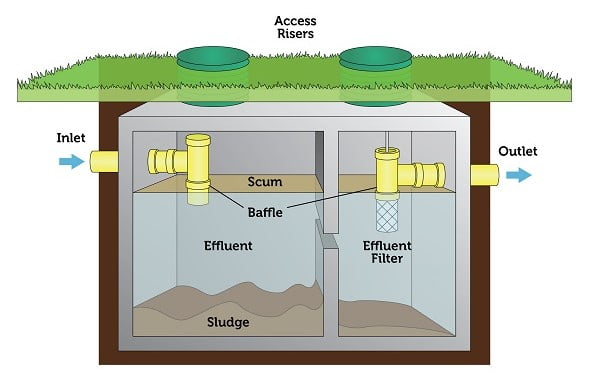Do septic tank additives work? You have probably seen them in commercials or on store shelves while shopping. There are two distinct categories of additives used in a septic system:
- Chemical – includes inorganic and organic compounds
- Biological – includes yeast, bacteria, and enzymes
There are approximately 1,200 additive products on the market today, many of which contain enzymes that can be purchased through septic tank pumpers, discount stores, and chemical companies. These additives vary in cost and depending on the brand, it may be cheaper to simply have your septic tank pumped more often than every 3 years as required by Wisconsin law.

There are special instances when the use of a biological additive may be warranted, such as when a home’s occupants take antibiotics or other prescription medications. It should be noted that research is still needed in this area. Some research has already shown that additives had no significant effects on septic tank bacterial populations.[1]
Bacteria die off conditions occur in a septic tank when they are destroyed by the presence of toxic substances. Die off conditions were observed when adding a concentration of 1.85 gallons of liquid bleach, 5.0 gallons of liquid Lysol cleaner, or 11.3 grams of Drano drain cleaner to a standard 1,000 gallon septic tank. Other factors that can cause die off include the use of antibacterial agents, and in certain cases, medications taken by the home’s occupants. Please keep in mind that this is an extreme example of harsh chemical use and shouldn’t be a normal occurrence in a typical household. Yes, such a scenario can take place but it is unlikely to happen.
Septic Tank Additives – Research
Research suggests that some biological additives may increase the biological activity to the point where excess solids can be carried into the soil absorption system. This occurs when anaerobic decomposition of solids causes the formation of methane gas. As they rise, bubbles push solids up from the settled portion of the septic tank. Ultimately, this may lead to solids “carryover” to the soil absorption system (drain field) where clogging can ensue.
Some septic system additives advertise the ability of their enzymatic product to reduce scum. However, the effects of degradation in the scum layer are believed to be detrimental to a soil absorption system. The scum layer holds fats, grease, and floatables, preventing their escape to the drain field. Enzymatic products can break up this scum layer and increase its mobility, allowing it to enter the drain field. This can lead to drain field failure sooner than normal as solids from the scum layer coat the sand layer and prevent waste water from draining away.
Do I Still Need to Pump?
Claims made on the effectiveness of additives to either eliminate pumping of a septic tank or restore permeability of the drain field are unsubstantiated. No product will allow a homeowner to escape a regular septic tank pumping and maintenance schedule. Septic tank pumping regulations for Wisconsin require pumping and inspections scheduled for every 3 years. To maximize your septic system’s life span you should have your tank pumped more often. At Allied Well, Septic & Pump, we recommend that home owners have their septic tanks pumped once a year to remove solids and scum. Depending on the septic tank additive, the cost of having your tank pumped may be cheaper and is much more effective.
Be aware that routine pumping is required by law for systems installed in Wisconsin per the Wisconsin Fund Grant Program and DSPS 383.54.
[1] Pradhan S, Hoover MT, Clark GH, Gumpertz M, Wollum AG, Cobb C, Strock J. Septic tank additive impacts on microbial populations. J Environ Health. 2008 Jan-Feb;70(6):22-7, 51. PMID: 18236933.
